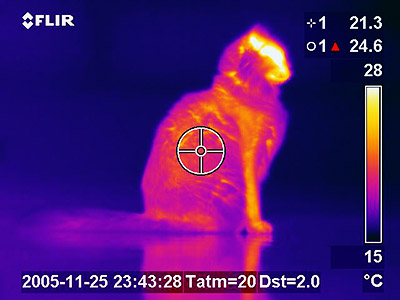Jenny Robinson left a comment on our blog to ask if it would be possible to heat a Passive House with cats…
So we thought we would check to see how many cats would be needed…
In The New Autonomous House, my second year tutors at Nottingham University, Brenda and Robert Vale postulated the possibility of using cats to heat a super insulated home*.
They cited the example of The Countess of Groan in Titus Groan surrounded by a sea of white cats in her castle, but what if we were to employ modern Passive House standards?

Before we work out the heat requirements, we must first establish the heat output of the proposed heating system, in this case domestic cats.
As cats vary considerably, we shall use a standardised cat with a nominal weight of 3kg.
According to CIBSE Guide Volume A; Design Data Table A7.3, pA7-4
“… a 3kg cat has a heat output of 14.8 Watts.”

To convert Watts (W) to kilowatt-hours (kWh), the energy (E) in each kWh is equal to the power (P) in Watts, times the time period t in hours (hr) divided by 1000:
E(kWh) = P(W) × t(hr) / 1000
So
kWh = W × hr / 1000
Therefore the energy output in kilowatt-hour per cat per annum is:
E = 14.8W × 24*365h / 1000 = 129.65 kWh

To comply with Passive House Standards, a building must have an annual heating demand as calculated with the Passivhaus Planning Package of not more than 15 kWh/m² per year in heating**.
If we assume a house of 150m2 the annual space heating energy demand is:
15kWh/m² × 150 m² = 2250kWh
The number of cats required is therefore:
2250kWh / 129.65kWh = 17.35 cats
It is probably best to round up to an
average of 18 whole cats to avoid complaints.
This equates to 1 cat per 8.33m².
As cats cost about £120pa to ‘run’ this equates to a total running cost of £2,160.00 pa.
This cost can be compared to £167.00 for gas or £327.00 for Electric, though the installation cost is of course less for cats.
The calculations have used an average heat load. In reality the heat load will vary considerably through the year. You will need considerably more cats in colder weather and less during mild weather.
In hot weather you can of course let the cats out for a run about, but this represents a significant waste of resources if you continue to feed them!
As cats cannot be used for cooling, you would also have to introduce an alternative cooling system such as lizards or other cold blooded animals.**

